On 18 April 2007 Poland and Ukraine won the bid to host the 2012 UEFA European Championship. Of course, matches would be held in the capital of Poland and a new stadium was needed. It was built on the site of the 10th-Anniversary Stadium demolished in 2008.
By the time of its demolition, the latter looked quite depressing and was used as a bazaar, which was one of the largest in the world.
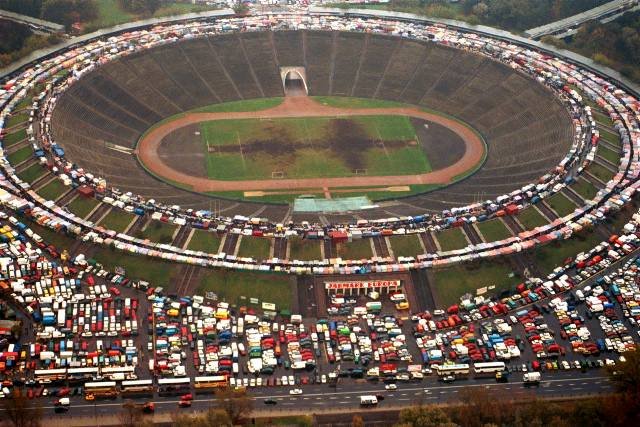

The National Stadium was built on the ground of the demolished stadium. First construction work began on 15 May 2008 — 3.5 months after the consortium of architects from three different companies presented a conceptual design of the project. The construction of the stadium began on the 7th October of the same year.

European companies from different countries (Poland, Germany, Austria and others) participated in the project. The opening of the stadium was scheduled for 27 August 2011 during an official ceremony, but the stadium was not done by that date.
The construction was completed on the 29th of November and the opening ceremony was held on 29 January next year. Exactly a month later on 29 February, the first friendly match between Poland and Portugal was held.
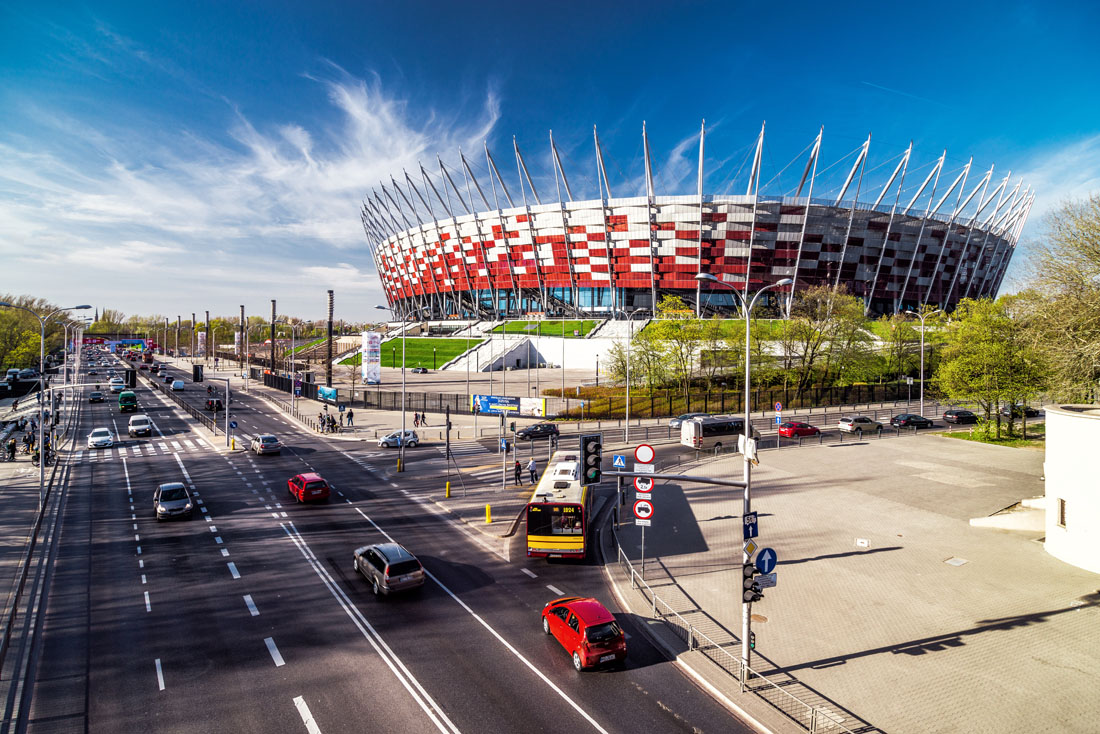
For my taste, the stadium turned out to be a bit too colorful and the Wroclaw or Gdańsk stadiums seem to be more elegant but this is nit-picking and a matter of taste. The National Stadium is the main stadium of the country and has already become one of the symbols of Warsaw and therefore its flashy look doesn’t cause any harm.
Some figures: its capacity is equal to 58 thousand people (56.8 according to the UEFA assessment); construction years — 2008 to 2011; construction cost was nearly 2 billion złoty.
The stadium is actively used for a variety of events and activities. Besides football matches the stadium hosts concerts (already visited by Madonna, Coldplay, Depeche Mode and others) and the annual “Science Picnic”. There is also karting, a viewing point, a miniature of the city and much more. We can definitely say that the stadium has become part of the city and is actively in use.
The stadium in Warsaw, of course, had its difficulties — the opening ceremony was postponed for five months (almost half a year), but besides that nothing unusual happened. To not get bored let’s now move on to Russia.
The stadium which we will now consider is called the Krestovsky Stadium (also known as the Saint Petersburg Arena or Zenit Arena). It is located in St. Petersburg and will host the matches of the 2018 FIFA World Cup which will take place in Russia next year.
Its construction began in the summer of 2007 — the first stone was laid. In August of the same year, then-governor of Saint Petersburg Valentina Matvienko said that the first match at the arena will be played already in March 2009. If she only knew how that date was far from the reality!
Same as in Warsaw the Krestovsky Stadium was built on the site of the old stadium named after S. M. Kirov, which had been demolished in 2007. Since that moment the stories of the two stadiums go in different directions. The story of the Krestovsky Stadium is too confusing to describe it in a few words and I see no reason to go into the details — it is not the purpose of this material.
The Krestovsky Stadium is a typical example of how some buildings are being erected in Russia. They are constructed for years during which large amounts of money disappear. Moreover, often these are the most important and expensive projects in the country that are located in advantageous places.
I already partly mentioned this in the article about Syria and that argument also fits here. There are many unfinished buildings in undemocratic countries. Before the Business Center SkyLight became the HQ of mail.ru (major Russian e-mail provider) this building for years looked like this:

Before the Multipurpose Center “Oruzheiniy” criminally disfigured Moscow’s skyline, it had already crippled it with its skeleton:
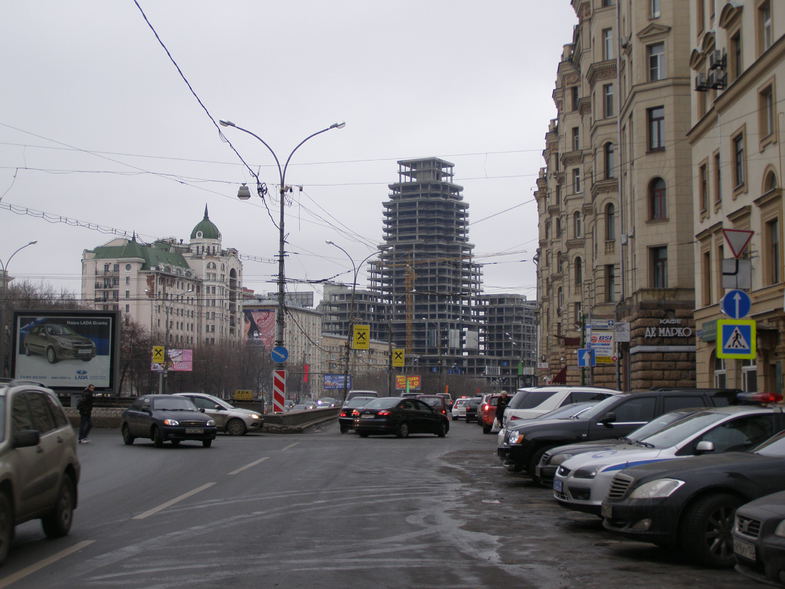
Here’s is a view of the Kremlin so you don’t think that I’m exaggerating:

This monster can be seen from everywhere in Moscow but let’s discuss it some other time.
The Krestovsky Stadium was built in that same style but only worse: large cash injections by the state, the change of contractors, the opening ceremony was delayed more than ten times, numerous cases of corruption. Even slave labor from North Korea was used on the construction site! And what did we get in return?
The first match at the stadium was held on 22 April this year — ten years after the start of the construction, but that’s not all! Besides the 48 billion rubles spent during the construction, the stadium is, in fact, not fully completed! The field is completely ruined:
The roof is leaking:
During the first match workers will manually try to fix it! And we are “lucky” that it rained that day — if it would be a sunny day we wouldn’t know that in the most expensive stadium in the world the roof is leaking like in some wooden farmhouse.
There are also leaks under the tribune of the stadium:
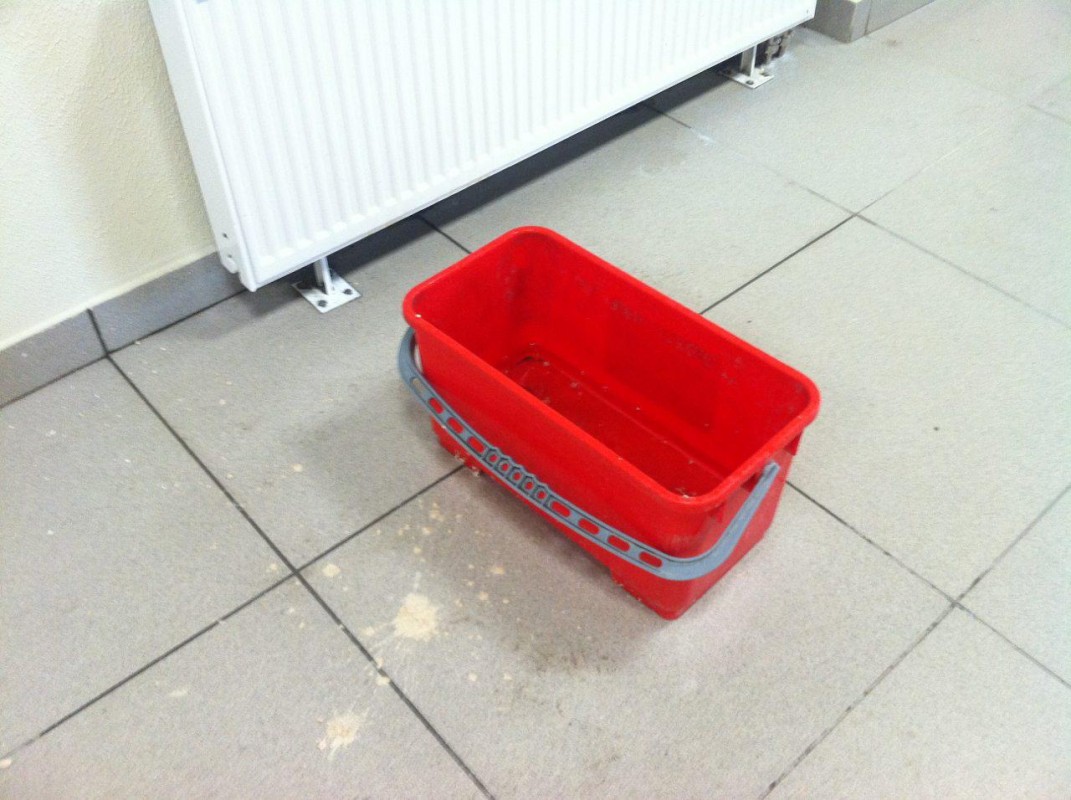
There’s no need to comment this or the photo of the painted grass that goes around the internet:

And yes, the stadium will be further “worked” on. Krestovsky needs another 1.5–2 billion rubles to bring the stadium to an adequate condition. It is also not entirely clear whether the stadium will have the planned functionality as it has constructive errors as well as plenty of minor problems.
Visually, the stadium looks like a landed flying saucer…
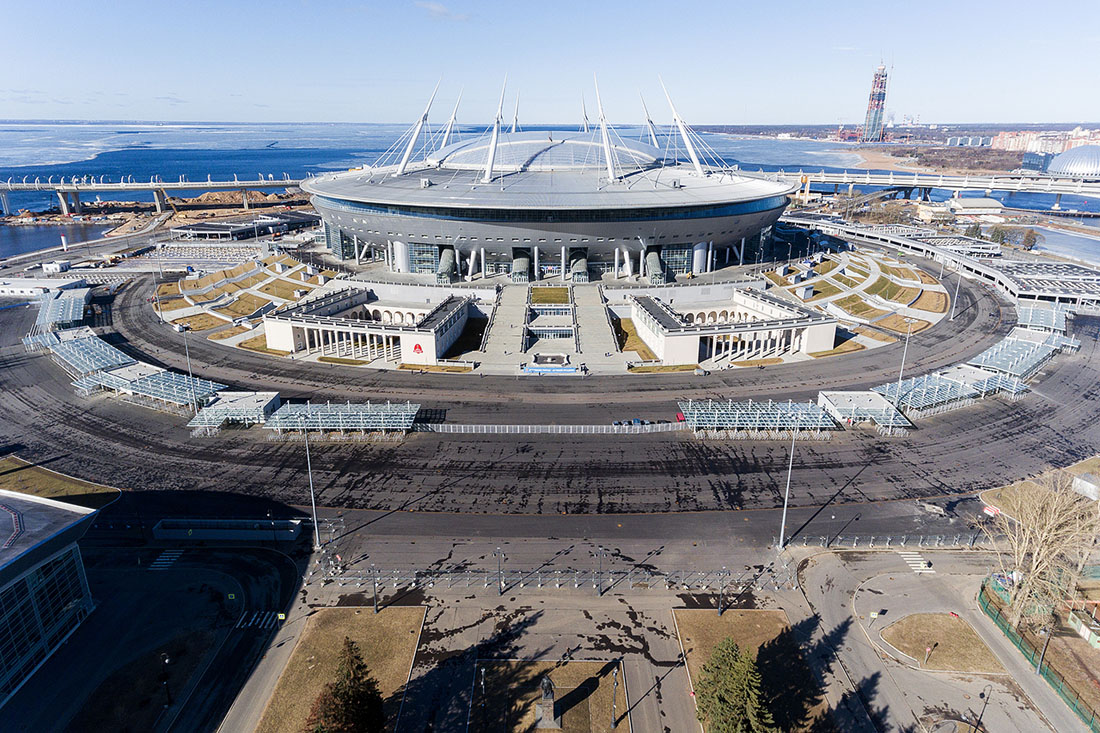
The materials of the stadium and the construction itself look cheap — especially the pathetic gray “bathroom tile”.
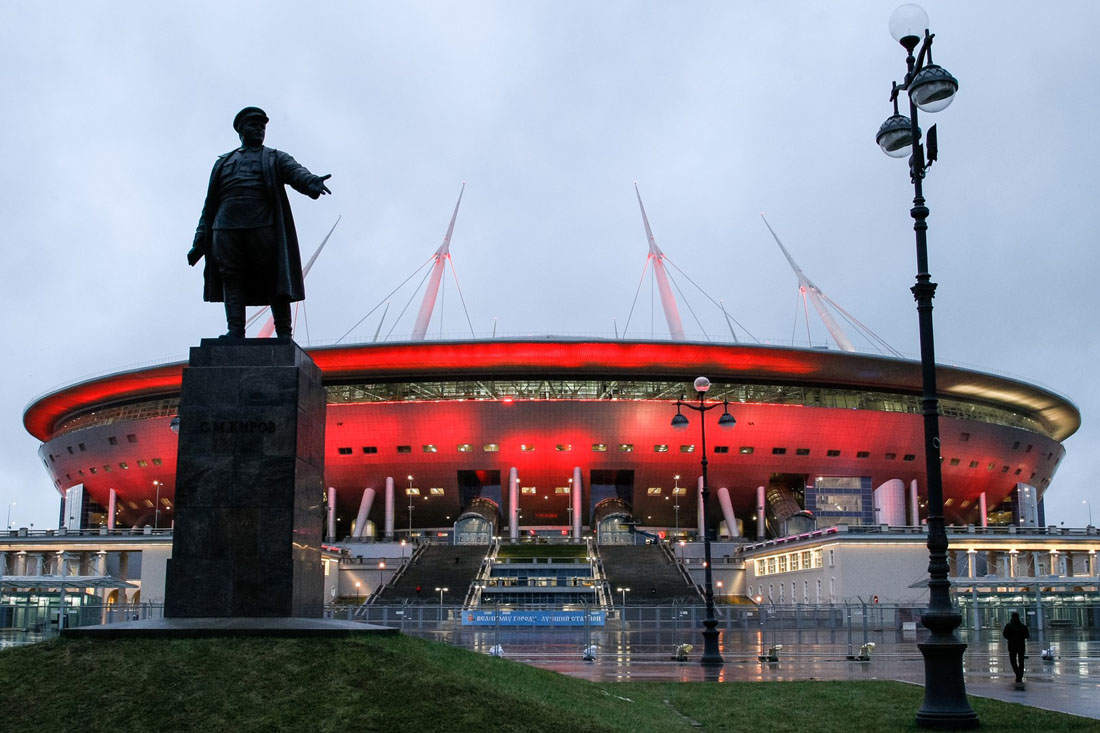
The columns raise associations with toothpicks.

Apparently, there was not enough money to hire a designer who could make a decent banner.

The extremely trivial “Russian” font which in 2017 is not even suitable for a tavern and the hyphen instead of a dash is another “victary” of the Russian design (another “victary” — 2014 Sochi Winter Olympics logo which I’ve already noted before).
Surprisingly, the architect of the stadium is the famous Kisho Kurokawa who died in 2007. Apparently, his death only worsened the situation. On the other hand, we can find comfort in the fact that Kisho left us in 2007 when the work on the stadium began. Judging by the way the stadium was built I don’t think Kisho could go through such a nervous project that lasted for ten years. Even if he survived he would certainly die of shame after seeing how his idea was executed.
Let’s now compare these two stadiums. I’ve already mentioned the construction costs in złotys and rubles, let’s convert them to dollars. Since I’m not familiar with the exact dates when the payments were held I, therefore, used the lowest and the highest exchange rate of the dollar against the złoty and the ruble for the corresponding period of the construction of each stadium.

As we can see both the złoty and the ruble had experienced some turbulence during the construction of the stadiums but the range for the Russian stadium is just dramatic (anything can happen in Russia over ten years). I should also note that the Krestovsky’s minimal $ 577 million is a very “delicate” figure as the ruble lost very much against the dollar in 2014–2016 (see chart below), but most of the time it was stable and the cost, respectively, is closer to the two billion dollars, rather than 577 million.

Let’s summarize. It’s just slightly more than a quarter of a century with the collapse of the Soviet Union but the former communist countries are already living in two different realities. Poland is an active member of the European Union. A relatively poor country built from scratch the main stadium of the country which has become one of the symbols of the city and is actively in use. The construction didn’t take decades and it involved European companies from different countries. Each party did what it is best at and we saw the market economy in action. Yes, there were some difficulties and the stadium opened later than planned but it is not critical.
The second stadium was built in Russia which decided to go its own “special way”. This “special way” resulted in the long years of construction of a stadium that is located in the second largest city of Russia — not even in the capital. It took ten years to bring to the public an unfinished wreck with an incredible number of mistakes and problems. And Russians has paid for this “wonder” a billion or two dollars.
There are people in Belarus and Russia who seriously claim that “Everyone steals! It is the same everywhere! Corruption is everywhere!” It is a complete lie. Such blatant corruption is only present in underdeveloped backward countries and in democratic countries any public case of corruption leads to a trial and the imminent resignation of the associated politicians (see the example of the Prime Minister of Iceland). What happens in Russia? Everyone is laughing at the stadium but no one has said a word about the perpetrators. As usual, everyone will laugh and forget about this incident and these same corrupt people will continue to practice the same strategy throughout the whole country.
Krestovsky is another example of the fact that if a country and its population want to live honestly, without corruption and theft — that country and these people have nothing to do with Russia. The only ally is the West, where human effort is valued, resources aren’t wasted, and buildings that shape the appearance of the city are designed and build by professionals from private companies and not by friends of the officials.



























Comments